

Planning and building a paludarium is seriously enjoyable. So when it comes to deciding what decor and plants will go in our paludariums, pictures like these are invaluable for showing us what we could achieve with a little knowledge, a lot of planning, and a moderate amount of effort. If you have paludarium pictures you would like to include here, please send images with a little description to info@paludariums.net. We'd love to see your work!
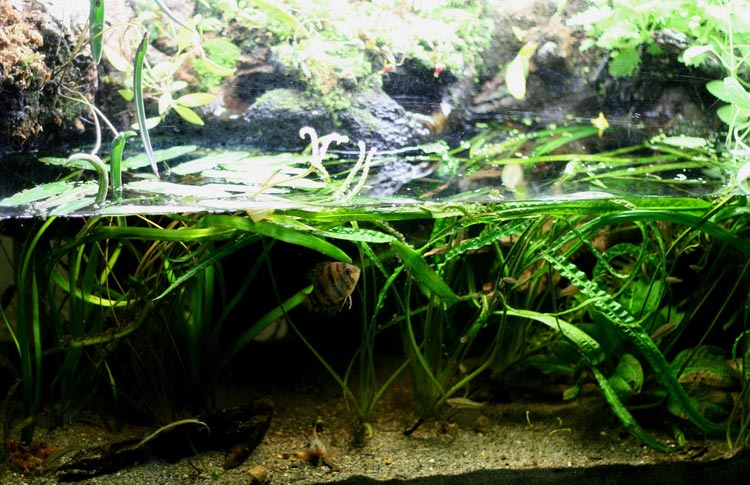
Setting up a paludarium primarily for fish requires a different approach than if a land dwelling species is present. The water section will generally be deeper, with no requirement for slopes, or steps if nothing will leave or enter the water. This paludarium is planted aquatically with various Cryptocoryne species, at least one of which has produced emersed flowers. The continually moist bogwood at the water's edge has developed some nice moss patches.
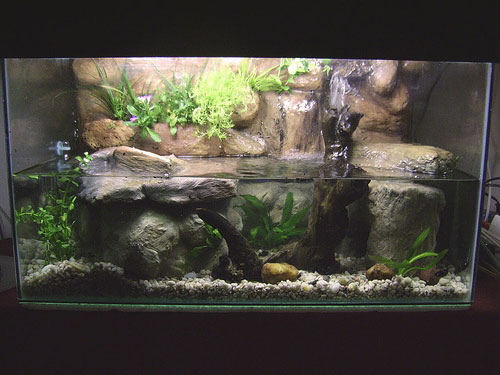
A beautiful riparium. A riparium usually has some form of water movement - in this case a waterfall. A flowing water biome has unique challenges of course. The extra water movement creates splashes over a wide area, typically necessitating the use of aquatic, or semi-aquatic plants rather than terrestrial species. This tank is lightly planted. With good lighting, and a bit of patience, numerous species could be encouraged to 'green' the back wall of this paludarium.
This tank is a great example of how to build a paludarium without spending huge amounts of money. Such paludarium fish tank installations can be created out of any old aquarium, with a suitable background to hide the pump or filter that is used to create the waterfall. Generally these aquarium backgrounds are made of foam and are attached to an empty tank with silicon aquarium sealant. Such paludarium setups can be very simple to build, but do remember tank maintenance! Filters need regular maintenance, so make sure that they can also be removed; don't permanently seal them in! Although easy to use, foam backgrounds don't allow creepers and mosses to grow on them as easily as more porous natural surfaces do (e.g. coconut, cork or tree fern panels, or even clay). Compare this tank with some of the others made using natural materials below.
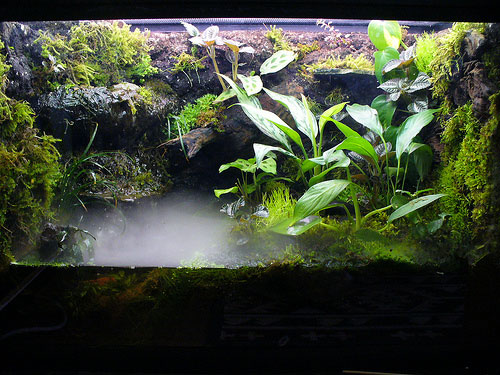
This wonderfully foggy and humid paludarium has numerous 'shelves' on the back wall; outcroppings that make perfect perches for animals, or surface on which clumps of moss can grow. The perfect paludarium for moisture loving amphibians. Dendrobates dart frogs would certainly enjoy such a habitat. The fog effect is produced by small ultrasonic mister - these are inexpensive and very effective at adding some atmosphere to any paludarium.
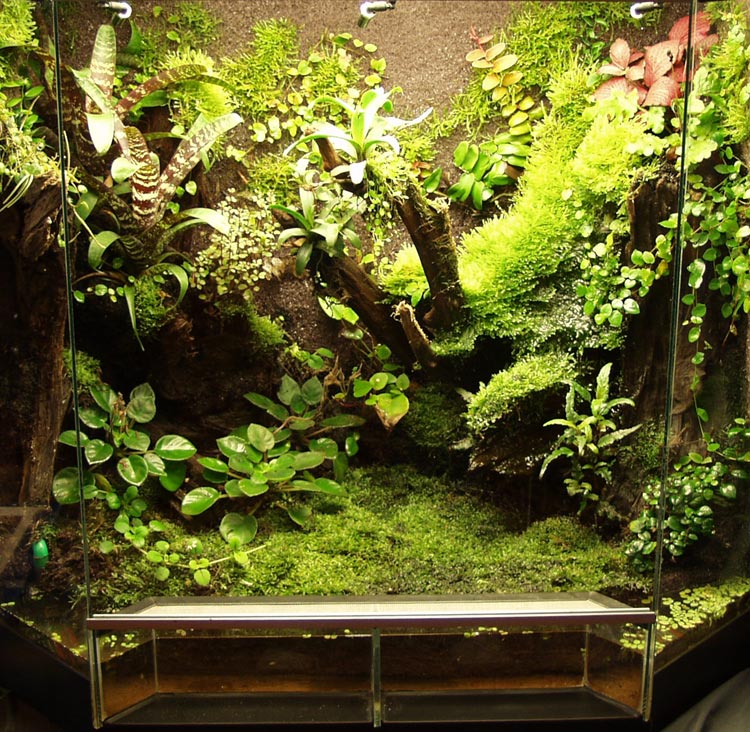
This exceptional well planted tank has huge, moist, beds of moss, that would make any terrestrial frog species feel right at home. It is fitted with coco fiber panels from top to bottom, which provide the perfect substrate for plants up and down the tank. Technically a paludarium, the volume of water is smaller than other installations on this page, and some may consider this a vivarium, or terrarium. It is primarily planted with smaller plant species: mosses (Java moss, Christmas moss); semi-aquatic species, growing emersed (Java fern and Anubias); whilst creepers (Ficus pumila) cover the walls and floor. Specimen plants like bromeliads are mounted to pieces of wood, to complete the tropical jungle atmosphere. All of these plants thrive in a tropical rainforest climate, and really appreciate misting several times each day. Although lushly planted, this display is still nowhere near fully established, with much of the coco panel background still clean and new. This tank will only get better!
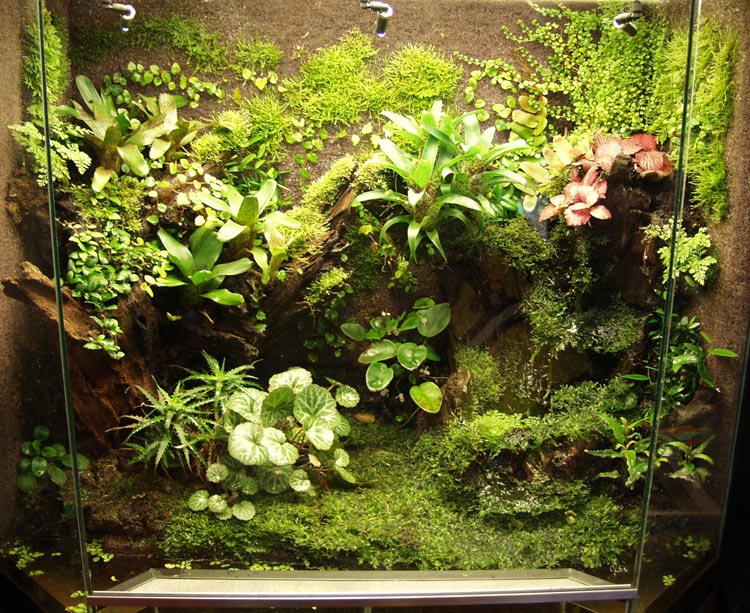
This paludarium is lushly planted with mosses, bromeliads and small leafed climbers. Three misting nozzles can be seen at the top of this image; regular misting is essential to maintain the rainforest-like humidity. Other species include the strawberry begonia (Saxifraga stolonifera), earth star (Cryptanthus microglaziouii), aswell as the obligatory Anubias, creeping fig (Ficus pumila), Java moss, and Java fern.
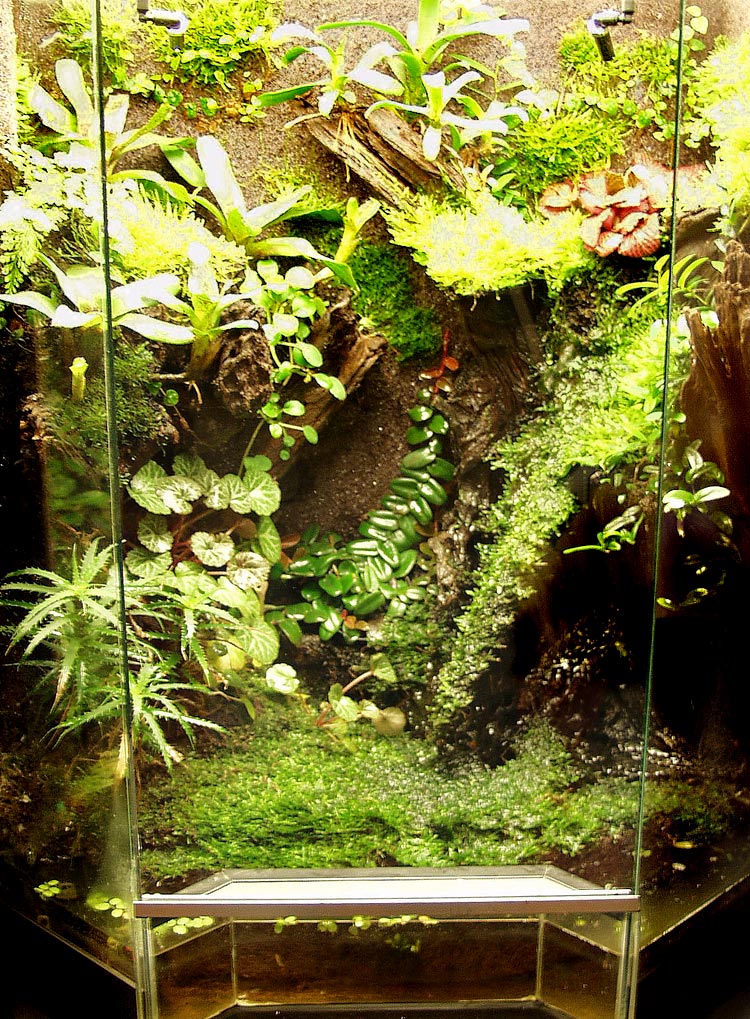
This taller tank is less established than some; there are clear drier zones (at the top of the tank) and more moist areas (the floor). This can be very useful, as it allows animals such as frogs to experience the moisture level that suits them best. A tall paludaria makes an excellent tree frog habitat; although the tank has little surface area, it makes up for this by providing dozens of leaf and branch perches up and down the back wall. Although nicely planted here, this tank will look spectacular once it has had another year or twos growth. Plant species are very similar to the tank above, with Java moss, strawberry begonia and earth star towards the bottom, bromeliads higher up, and creeping fig and more Java moss filling in all the gaps. This would make the perfect pet frog habitat, both for larger ground dwellers such as Dendrobates tinctorius or azureus or smaller thumbnail species that prefer life amongst the bromeliads.
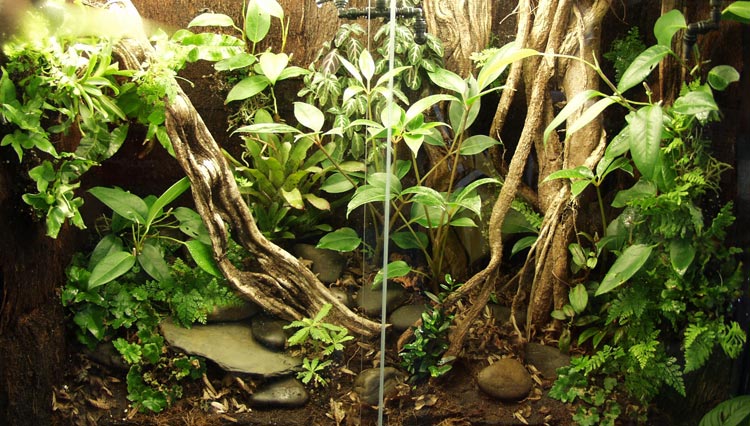
Some paludaria may only have small bodies of water. These may ultimately be to provide drainage for a heavily misted tank, rather than as a feature in itself. Exactly where the line between a paludarium and vivarium lies is of little consequence. Such tanks typically have less mosses and more leafy plants, unless misted several times each day.
This wonderful 3 foot wide tank has a waterproof glass bottom, and adequate front window ventilation to keep the front glass clear. Although marketed as a Terrarium, it works as the perfect Paludarium. Front-opening doors, and removeable top for easy access and effective maintenance. Available in a wide range of sizes: with a larger surface area for ground/water dwelling species, or taller for leaf dwellers. Suitable for just about any paludarium inhabitant.
The top is equipped with closable inlets on both sides - this allows access for wires and tubing without offering an escape route for paludarium animals or the tiny invertebrates with which they are being fed. Suitable for powering Heat Wave rocks, waterfalls, filters and sensors, or injecting water through misting systems, external canister filters, etc.
All in all a great enclosure, providing a perfect environment for plants and animals, yet easy maintenance for the paludarium keeper. Available from Amazon and other good pet stores.